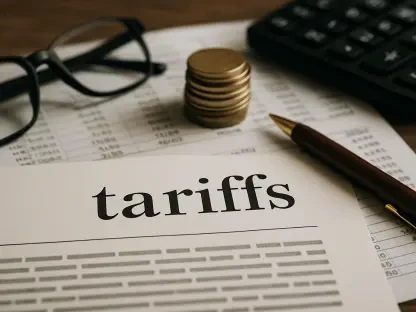The U.S. and global stock markets experienced a dramatic decline on August 5, 2024, inciting fears and speculations about an impending recession. The Nasdaq Composite, the S&P 500, and the Dow Jones Industrial Average suffered their worst trading day in nearly two years, losing 3.4%, 3%, and 2.6%, respectively. Moreover, Japan’s Nikkei 225 plummeted 12%, its steepest single-day fall in four decades, owing to an interest rate hike by the Bank of Japan. This article delves into the potential causes, far-reaching implications, and various responses to this sudden financial turmoil.
The Trigger: Japan’s Interest Rate Hike
One of the primary catalysts for the market panic was Japan’s decision to shift from years of negative interest rates to a target rate of 0.25%. This significant policy change disrupted the global markets, as it caused a recalibration of investments funded with cheaper yen. Investors, who had long relied on the low-interest environment to finance high-yield investments, found themselves abruptly facing a higher cost of capital. The immediate effect was a surge in the yen’s value against the dollar, which led to a broad sell-off in technology and AI stocks. These sectors were particularly vulnerable as they had been buoyed by leveraged investments on low-interest yen. Market observers noted that while the change in monetary policy was needed, the abruptness of this move caused widespread uncertainty and shock.
Such abrupt policy decisions have historically led to ripple effects in global financial markets, and this instance was no different. The spike in the yen undermined investor confidence in tech stocks, sectors that have been primary beneficiaries of low borrowing costs over the past decade. As tech stocks plummeted, panic spread to other market sectors, causing a widespread sell-off. Investors scrambled to reassess their portfolios and adapt to the new monetary landscape, leading to an intensified sense of instability and hesitation across global markets. Despite the shock, experts predict that the markets will eventually stabilize as the new monetary policies are fully digested and incorporated into investment strategies.
Weak Job Market Data Adds Fuel to the Fire
Compounding the market anxieties was disheartening job market data released the previous week. U.S. employers added only 114,000 jobs in July, significantly below expectations, and the unemployment rate rose to 4.3%, a high not seen in nearly three years. These figures stoked fears that the Federal Reserve might have to cut interest rates more aggressively to stabilize the economy. The poor job numbers added a layer of concern that the U.S. economy might be weaker than previously thought, sparking more volatility in an already trembling market.
Economists, however, cautioned against drawing hasty conclusions from the poor job report, noting that a single month’s data should not dictate long-term economic policy. They argued that while the weak employment numbers were concerning, they did not necessarily signal an imminent recession. Historical data suggests that monthly job figures can be volatile and may reflect short-term fluctuations rather than long-term trends. Raymond Vyz, an economist with Global Insights, pointed out that one weak monthly report should not form the basis for predicting economic calamities.
Nonetheless, the weaker-than-expected job growth did bring into focus the ongoing challenges in the labor market, particularly in sectors such as manufacturing and retail, which have been sluggish in their recovery. Experts emphasize the need for a balanced approach in monetary policy that takes into account a wider range of economic indicators before making any significant changes. Taking a holistic view of the economy rather than reacting to singular data points can provide a more stable foundation for sustained growth and market confidence.
Economics of Market Dynamics
Despite the dramatic downturn, many analysts view the situation as a market correction rather than an indication of a looming recession. Joe Brusuelas, chief economist for RSM US, described the turmoil as “just a good old-fashioned market panic.” He emphasized that the sell-off was largely driven by the unwinding of “complicated, heavily leveraged trades” that had previously inflated stock values. Brusuelas, along with other market watchers, noted that while unsettling, such corrections are part of the normal market cycle and are necessary to expunge inefficiencies.
Experts pointed out that while the turbulence might lead to an economic slowdown, the overall U.S. economy remains fundamentally robust. Consumer spending is strong, and the service sector is expanding, providing a buffer against potential declines in economic performance. Many stocks, despite the recent sell-off, are still trading at relatively high valuations, suggesting that underlying investor confidence in the market remains intact. This resilience is further buoyed by solid corporate earnings and robust consumer sentiment, elements that are often reliable indicators of economic health.
However, the episode did highlight vulnerabilities in the market, especially those sectors built on heavy leverage and speculative investments. The sudden deleveraging, while painful, serves to recalibrate market values in a way that may lead to more sustainable growth moving forward. Investors and policymakers alike have an opportunity to learn from these dynamics, recalibrating their strategies to better navigate future uncertainties. The importance of clear-eyed analysis and prudence in investment strategies cannot be overstated in such volatile times.
The Global Shift Away From Easy Money
A significant trend contributing to the market panic is the global shift away from years of “easy money.” Central banks around the world, including Japan’s shift from negative rates, are recalibrating their monetary policies. This transition has resulted in increased volatility as markets adjust to a new economic paradigm. Central banks’ determination to curb inflation and restore policy normalcy after years of extraordinary measures is reshaping the landscape for investors everywhere.
Investors, who have long relied on cheap borrowing to fund high-yield investments, are now grappling with a more expensive capital environment. This shift has led to the recalibration of asset values, particularly in highly leveraged sectors such as technology, which experienced significant declines amid the panic. The shift to higher interest rates forces a reevaluation of risk and return calculations, with many investors opting to reduce exposure to riskier assets. The process, while unsettling, is crucial for restoring a more balanced and sustainable economic environment.
The transition has not been without its challenges. Markets accustomed to prolonged periods of low-interest rates are understandably jittery as they confront the new reality. Nonetheless, experts argue that the global economy is capable of adapting, and the volatility seen now will likely give way to greater stability as these new policies take root. The key for both investors and policymakers is to stay focused on long-term fundamentals and avoid overreacting to short-term market fluctuations.
Federal Reserve’s Cautious Approach
The Federal Reserve has adopted a cautious approach, continuing to maintain current interest rates while monitoring the situation. Chicago Fed President Austan Goolsbee highlighted that the Fed’s focus remains on sustaining job market health, stabilizing prices, and preserving financial stability. This measured approach reflects a deep-seated commitment to ensuring that monetary policy supports broader economic goals without triggering unnecessary disruptions.
Fed officials have indicated that any decision to cut rates will be based on comprehensive economic data rather than reacting to isolated market shocks. This measured stance aims to avoid premature or disruptive actions that could exacerbate market instability. Officials emphasized the importance of patience and awaiting more data, noting that hastily reducing rates could spur inflationary pressures or create other unintended consequences. The balanced approach seeks to provide a steadying hand amid market turbulence, leveraging data-driven insights to inform policy actions.
The Fed’s resolve to avoid knee-jerk reactions has been met with both praise and criticism. Some market players argue for quicker interventions to sustain market confidence, while others applaud the deliberate pace as prudent and necessary for long-term stability. The Fed’s approach underscores the complexity of navigating modern economic landscapes, where myriad variables must be weighed and measured against each other. Ultimately, the goal is to maintain a trajectory that supports sustainable growth and financial health over the long run.
Political Ramifications and Responses
Politically, the market turmoil has not gone unnoticed. President Biden’s administration has thus far refrained from public commentary on the Wall Street panic. However, escalating market conditions may compel the administration to address the issue directly in the near future. The silence, some analysts argue, is strategic, allowing time for a more considered response that takes into account a fuller assessment of the situation.
In contrast, Republicans, including former President Donald Trump, have been vocal in criticizing the current administration’s economic management. They argue that the market downturn reflects broader failures in economic policy, a perspective that is not universally shared among economists and analysts. Critics claim that the administration’s reluctance to address the situation publicly exacerbates investor uncertainty, while supporters contend that remaining measured and avoiding rash statements is beneficial for market stability.
The political dimension of the market turmoil is entwined with broader debates on economic policy and direction. As market conditions evolve, the administration will likely find itself under increasing pressure to articulate its stance and outline potential measures to shore up the economy. The interplay between market realities and political strategies will shape the discourse ahead, influencing both policy decisions and public sentiment.
Optimistic Indicators Amidst Turbulence
Amid the market chaos, there were positive indicators showing resilience in the service sector, which accounts for a large segment of the U.S. economy. The sector experienced growth in July, thanks to new orders and increased hiring, presenting a counterpoint to the more pessimistic labor market data. This sectoral growth suggests that consumer demand remains robust, supporting overall economic stability even in turbulent times.
Quincy Krosby, chief global strategist at LPL Financial, expressed optimism about the sector’s growth, suggesting it could help offset fears of a rapid deterioration in the labor market. This expansion offers a glimmer of hope that the economic fundamentals remain sturdy despite market volatility. Krosby’s insights underscore the importance of looking beyond headline figures to appreciate the underlying strengths within the economy. Other sectors, from healthcare to hospitality, are also showing signs of resilience, contributing to a more balanced economic outlook.
These positive indicators are crucial for maintaining confidence among consumers and businesses alike. They remind stakeholders that despite short-term fluctuations, the broader economic landscape holds pockets of strength that can sustain growth. The path forward requires leveraging these strengths while addressing weaknesses to ensure a more harmonious and sustainable economic trajectory.
Balanced Responses to Market Conditions
On August 5, 2024, the U.S. and global stock markets faced a significant downturn, sparking concerns and speculation about a looming recession. Notably, the Nasdaq Composite, the S&P 500, and the Dow Jones Industrial Average experienced their worst trading day in nearly two years, dropping by 3.4%, 3%, and 2.6%, respectively. International markets were also affected, with Japan’s Nikkei 225 suffering a dramatic 12% decline, marking its steepest single-day fall in four decades, primarily due to an interest rate hike by the Bank of Japan.
This sharp decline in stock markets raises questions about the underlying causes, such as geopolitical tensions, economic data releases, or shifts in monetary policy. Additionally, the impacts of this sudden financial instability are far-reaching, potentially affecting global economic growth, investor confidence, and market volatility. Various stakeholders, from government officials to financial analysts, are actively monitoring the situation and weighing in on potential responses. This includes considerations for policy adjustments, fiscal measures, and other interventions aimed at stabilizing the markets and mitigating further repercussions.
The article examines these factors in depth, exploring how different sectors and economies may be affected and what measures might be implemented to prevent a full-blown recession. Understanding the causes and implications of this market turmoil is crucial for investors, policymakers, and the general public as they navigate the uncertainties ahead.









